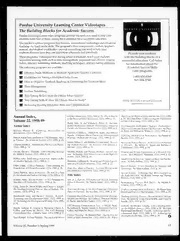
Journal of Developmental Education 1998 - 1999: Vol 22 Index PDF
Preview Journal of Developmental Education 1998 - 1999: Vol 22 Index
Purdue University Learning Center Videotapes t PURDU& UNIVE RS TY The Building Blocks for Academic Success Purdue Learning Center video programs provide the tools you need to help your students learn how to learn, laying the foundation for a successful education. The teacher’s edition integrates two formats-— instructional technology and classroom teaching—tv teach study skills. The program’s three components—videos, teacher's manual, and student workbooks—provide everything you need to help your students discover how they can learn more efficiently and effectively Provide your students These programs, videotaped live during actual workshops, teach your students with the building blocks of a important learning skills such as time management, organized and efficient reading successful education. Call today habits, effective notetaking methods, studying techniques, and test-taking strategies. for information about the The following programs are available: Academic Success Skills video programs. Effective Study Methods: A Modular Approach (Teacher’s Edition) Guidelines for Taking a Multiple-Choice Exam 1-800-830-0269 765/494-2748 How to Organize Textbook Reading, or Unraveling the Textbook Maze Time Management Lecture Notetaking Test-Taking Skilis I: How Do | Show What I Know? Test-Taking Skills II: How Do I Know What to Study? Purdue University is an equal access/equal opportunity institution Increasing Reading Efficiency: Rate and Comprehension Annual Index, of Ethics Instruction, 22(2), 1998, p. 36. Why it Must be Must be at the Heart of Ethics Instruction, 22(1), 1998, at the Heart of Ethics Instruction, 22(1), 1998, p. 32 p. 32. By Linda Elder. Understandintgh e Foundations Volume 22, 1998-99 of Ethical Reasoning, 22(3), 1999, p. 30 Penny, Mary D., and William G. White, Jr. Develop- Author Index mental Mathematics Students’ Performance: Impact of Developmental Mathematics Students’ Performance Faculty and Student Characteristics, 22(2), 1998, p. 2 Impact of Faculty and Student Characteristics. By Mary Boylan, Hunter R. Exploring Alternatives to D. Penny and William G. White, Jr., 22(2), 1998, p. 2 Remediation, 22(3), 1999, p.2 Peterson, Cynthia L., Marilyn K. Burke, and Delores Segura. Computer-Based Practice for Developmental Exploring Alternatives to Remediation By Hunter R Burrell, Karen Irene, and Patricia J. McAlexander. /deas Reading: Medium and Message, 22(3), 1999, p. 12 Boylan, 22(3), 1999, p. 2 in Practice: The Synthesis Journal, 22(1), 1998, p. 20. Spann, Milton G., and Barbara J. Calderwood ncreas- Increasing Student Success: An Interview with Edward Casazza, Martha E. Strengthening Practice with Theory, ing Student Success: An Interview with Edward A 1. Morante. By Milton G. Spann and Barbara J 22(2), 1998, p. 14. Morante, 22(1), 1998, p. 16. Calderwood, 22(1), 1998, p. 16. Caverly, David C. Techtalk: GAP A Reading Strategy Taraban, Roman, and Thomas Brothen. Special Fea- Reading and Writing Expectations at a Research Uni- for Multiple Sources, 22(2), 1998, p. 38. ture: Technology That Moves Learners in the Right Di- versity. By Catherine E.W ambach, 22(2), 1998, p. 22 rection, 22(3), 1999, p. 34. DePree, Julie. Small-Group Instruction: Impacto n Ba- Small-Group Instruction: Impact on Basic Algebra Stu- sic Algebra Students, 22(1), 1998, p. 2 Wambach, Catherine E. Reading and Writing Expecta- dents. By Julie DePree, 22(1), 1998, p. 2 tions at a Research University, 22(2), 1998, p. 22 Elder, Linda. Critical Thinking: Understanding the Special Feature: A New Paradigm for Teaching with Foundations of Ethical Reasoning, 22(3), 1999, p. 30. Zinn, Ava. /deas in Practice: Assessing Writing in the Technology. By Anne Koehler, 22(1), p. 36 Developmental Classroom, 22(2), 1998, p. 28. James, Patricia. /deas in Practice: The Arts as a Path Special Feature: Technology That Moves Learners in for Developmental Student Learning, 22(3), 1999, p. 22. Title Index the Right Direction. By Roman Taraban and Thomas Brothen, 22(3), 1999, p. 34. Koehler, Anne. Special Feature: A New Paradigm for Arts as a Path for Developmental Student Learning Teaching with Technology, 22(1), 1998, p. 36. (Ideas in Practice). By Patricia James, 22(3), 1999, p. Strengthening Practice With Theoin By Martha E. Casazza, 22(2), 1998, p. 14. Long, James D., David Riddle, and Cheryl S. Knight. The Teaching-Learning Process: Special Siudents’ Per- Assessing Writing in the Developmental Classroom Synthesis Journal (Ideas in Practice). By Karen Irene ceptions, 22(3), 1999, p. 16. (Ideas in Practice). By Ava Zinn, 22(2), 1998, p. 28 Burrell and Patricia J. McAlexander, 22(1), 1998, p. 20. MacDonald, Lucy, and David C. Caverly. Techtalk. Computer-Based Practice for Developmental Reading Teaching-Learning Process: Special Students’ Percep- Technology and Developmental Math, 22(3), 1999, p. Medium and Message. By Cynthia L. Peterson, Marilyn tions. By James D. Long, David Riddle, and Chery] S. 32. Technfoor Dleveolopgmeynta l Writing, 22(1), 1998, K. Burke, and Delores Segura, 22(3), 1999, p. 12 Knight, 22(3), 1999, p. 16. p. 34. CPT Reading Comprehension Test: A Validity Studs Techtalk: By David C. Caverly. GAP. A Reading Strat- Napoli, Anthony R., Lanette A. Raymond, Cheryl A. By Anthony R. Napoli, Lanette A. Raymond, Cheryl A. egy for Multiple Sources, 22(2), 1998, p. 38. By Lucy Coffey, and Diane M. Bosco. The CPT Reading Coffey, and Diane M. Bosco, 22(1), 1998, p. 8 MacDonald and David C. Caverly. Technology and De- Comprehesion Test: A Validity Study, 22(1), 1998, p. 8. velopmental Math, 22(3), 1999, p. 32. Technology for Critical Thinking: By Richard Paul. Placing It at the Developmental Writing, 22(1), 1998, p. 34. oO Paul, Richard. Critical Thinking: Placing It at the Heart Heart of Ethics Instruction, 22(2), 1998, p. 36. Why it Volume 22, Number 3, Spring 1999
